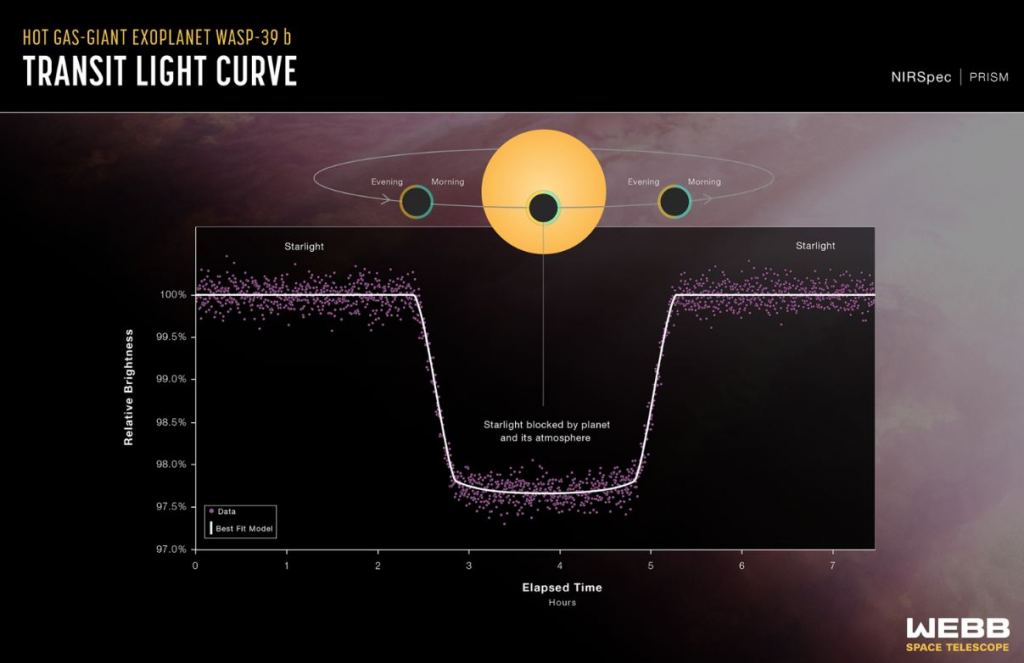Exploring exoplanet atmospheres in more detail was one task that planetary scientists anticipated during the long wait while the James Webb Space Telescope (JWST) was in development. Now, their patience is finally paying off. News about discoveries of exoplanet atmosphere using data from JWST seems to be coming from one research group or another almost every week, and this week is no exception. A paper published in Nature by authors from a few dozen institutions describes the atmospheric differences between the "morning" and "evening" sides of a tidally locked planet for the first time.
First, let's clarify what the "morning" and "evening" sides mean. Tidally locked planets don't spin, so one hemisphere constantly faces the planet's star. As such, there is always a part of the planet where it appears to be "morning," with the star barely peaking over the horizon. Alternatively, there's a part of the planet where it seems to be "evening," where the star is again just barely peaking over the horizon, but it would appear to be setting.
Typically, on Earth, we would think of the morning side as the star peaking over the eastern side, whereas the evening side would see the star setting into the western sky. However, exoplanets sometimes rotate in the opposite direction from planets in our solar system, so that mental model doesn't always work for them.
It's also important not to confuse the "morning" and "evening" sides with the "day" and "night" sides of the planet. On the day side, the full force of the star affects the planet, but on the night side, the star is never seen at all. The temperature differences on such a planet are massive, and cause much more extreme weather than anything we have experience with in our solar system.
That is the case for WASP-39b, one of the most studied exoplanets. It is a "hot Jupiter" and is roughly 1.3 times the size of the largest planet in our solar system, though it only masses in at about the same size as Saturn. It's 700 light years away and is tidally locked to its star.
Exoplanet hunters have intently studied this exoplanet since its discovery in 2011. It was the target of JWST's first exoplanet research when it began science operations. Since then, they've made several interesting discoveries, and the Nature paper describes a new one—that the "morning" side of WASP-39b is a few hundred degrees cooler than its "evening" side.
Fraser talks exoplanet atmosphere with expert Dr. Joanna Barstow.This temperature discrepancy is likely due to atmospheric conditions on the planet itself. The paper's authors believe there is an extremely strong wind on the planet that runs from day to night at thousands of miles an hour. The wind rotates from the day side through the evening side to the night side, then through the morning side back to the day side.
So, essentially, the morning side receives "air" that has been cooled while traveling through the planet's night side. However, that air is still a blistering 600 C (1,150 F). The temperature on the evening side, though, is hotter at 800 C (1,450 F), much hotter than any conditions found on any planet in our solar system.
Detecting such a temperature difference on an exoplanet hundred of light years away is an impressive technical feat, and the study's lead author, Néstor Espinoza, credits JWST's capabilities for enabling it. The telescope watched the planet both while it was traversing in front of its star, but also while it was next to it and emitting its own, admittedly much fainter, light.
JWST found methane in a different exoplanet atmosphere, as Fraser describes in this video.They were differentiating between the starlight filtered through the atmosphere of the planet and when there was no filtered starlight coming through allowed the researchers to make temperature estimates. JWST is so sensitive they were also able to split the data into semi-circles to differentiate the" "morning" side from the "evening" side. They also noticed that the "evening" side was slightly puffier, indicating that it was hotter than its counterpart.
The authors plan to use WASP-39b as a basis for studying future exoplanet atmospheres, and there are plenty more in JWST's dataset to look at. In addition, another round of data collection, Webb Cycle 2 General Observers Program 3969, will also focus on the atmospheres of other hot Jupiters. Finally, planetary scientists won't have to wait for their treasure trove of data anymore.
Learn More:
NASA - NASA’s Webb Investigates Eternal Sunrises, Sunsets on Distant World
Espinoza et al. - Inhomogeneous terminators on the exoplanet WASP-39 b
UT - Sulphur Makes A Surprise Appearance in this Exoplanet’s Atmosphere
UT - The Atmosphere of an Exoplanet Reveals Secrets About Its Surface
Lead Image:
Artists concept of WASP-39b.
Credits: NASA, ESA, CSA, R. Crawford (STScI)
 Universe Today
Universe Today

